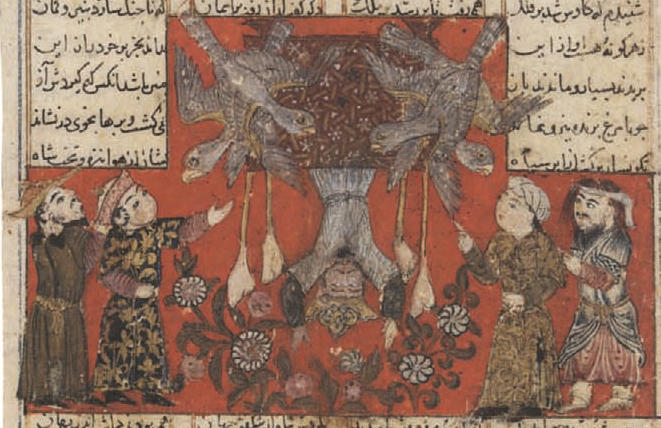
Register a SNAP EBT card with Amazon
Ilkhanid Illustration
Shahnama of Firdausi
(Metropolitan Museum's Small Shahnama)
Chapter 12b - Kay Kavus fights the King of Hamavaran.
Kay Kavus falls back down to earth
Isfahan, Persia, c.1330-1340AD



"Kai Kavus Falls from the Sky", Folio from a Shahnama (Book of Kings)
Author: Abu'l Qasim Firdausi (935–1020)
Object Name: Folio from an illustrated manuscript
Date: ca. 1330–40
Geography: Attributed to Iran, probably Isfahan
Medium: Ink, opaque watercolor, gold, and silver on paper
Classification: Codices
Credit Line: Bequest of Monroe C. Gutman, 1974
Accession Number: 1974.290.9
Frontispiece: Kaykavus Falls from the Sky, from the Metropolitan Museum's Small Shahnama.
A div (devil) persuaded Kaykavus to attempt to fly to heaven, either to learn its secrets or to rule it as he did the earth, according to different sources for the story. The method Kaykavus devised was to tie four strong yet hungry eagles to a throne, each with a leg of lamb tied to a post above it, so that in striving to reach the meat the eagles would lift the throne heavenward. The plan worked. However, as the epic tells us, the eagles eventually became exhausted and discouraged, so that the whole apparatus fell back to earth, with the shah miraculously escaping injury. All illustrations of this adventure, except this one, depict Kaykavus on his throne ascending into the sky; some include astounded spectators on the ground below. In this unique miniature, Kaykavus is falling head-first into a flower bed, the legs of lamb beside his head and the jumbled eagles above emphasizing the compelling force of gravity. Although he landed alone in a forest, far from help, here onlookers gesture toward him in amazement. It was the unique iconography of this painting as well as the strong central axis, the bilateral symmetry, the circle of flower heads, the star pattern on the throne, and the red ground in conjunction with the other colors — all found in later Indian painting - that led to the mistaken conclusion of a provenance on the subcontinent for this manuscript. This episode is not illustrated in either the First or Second Small Shannama manuscripts, but is found with an archaic and simplfied rendering of the ascent in the Injuid Shahnama of 1341.1 The only element in common between the two miniatures is the stepped-up format at the center.
Source: Illustrated Poetry and Epic Images: Persian Painting of the 1330s and 1340s Swietochowski, Marie Lukens, and Stefano Carboni, with essays by A. H. Morton and Tomoko Masuya (1994)
New York, Metropolitan Museum of Art
Title of Work: Shahnama (Gutman)
Manuscript: 1974.290.1-42, 2003.330.1-7
Accession Number: 1974.290.9
Chapter 12b - Kay Kavus fights the King of Hamavaran
Scene: Kay Kavus falls back down to earth
Format: Stepped within borders
Reconstructed Folio: A45v
Gregorian Date: 1335 (circa)
School: Isfahan
Source: Shahnama Project